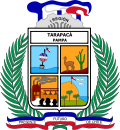Tarapacá Region
The I Tarapacá Region (Spanish: I Región de Tarapacá) is one of Chile's 15 first order administrative divisions. The present Tarapacá Region was created in 2007 by subdividing the former Tarapacá Region under Law 20.175.[2] It became operational on 8 October 2007.
|
Región de Tarapacá | |
|---|---|
 | |
 Map of Tarapacá Region | |
| Coordinates: 20°17′S 69°20′W / 20.283°S 69.333°WCoordinates: 20°17′S 69°20′W / 20.283°S 69.333°W | |
| Country | |
| Capital | Iquique |
| Provinces | Iquique, Tamarugal |
| Government | |
| • Intendant | Miguel Quezada Torres (UDI) |
| Area | |
| • Total | 41,799.5 km2 (16,138.9 sq mi) |
| • Rank | 6 |
| Lowest elevation | 0 m (0 ft) |
| Population (2017 census)[1] | |
| • Total | 324,930 |
| • Rank | 12 |
| • Density | 7.77354/km2 (20.1334/sq mi) |
| ISO 3166 code | CL-TA |
| Website | Official website (in Spanish) |
History
Chile's former Tarapacá region was a former Peruvian province, which was occupied by Chile under the 1883 Treaty of Ancón at the close of the War of the Pacific, and then formally annexed in 1929 by the Treaty of Lima.
The region was important economically as a site of intense saltpeter mining, before synthetic nitrate manufacturing became possible.
Geography
The Tarapacá region borders the Arica and Parinacota region to the north, Bolivia's Oruro Department on the east, the Antofagasta region on the south and the Pacific Ocean on the west.
Population
As of 2015[update], there were (estimated) 336,769 persons living in the region, for a population density of 8.0 inhabitants/km².
The largest city in the region is Iquique, with 164,396 inhabitants (2002 census).
Administration
In 2007, the former region of Tarapacá was subdivided to create the Arica y Parinacota Region to the north and the present day Tarapacá Region to the south. The Tarapacá region is further subdivided into two provinces: Arica and Parinacota.
| Province | Capital | Code | Comuna | Area (km²) |
Population (2002) |
|---|---|---|---|---|---|
| Iquique (011) | Iquique | 01101 | 2 Iquique | 2,242.1 | 166,204 |
| 01102 | 1 Alto Hospicio | 593.2 | 50,215 | ||
| Total of Iquique province | 2,835.3 | 216,419 | |||
| Tamarugal (014) | Pozo Almonte | ||||
| 01401 | 7 Pozo Almonte | 13,765.8 | 10,830 | ||
| 01402 | 3 Camiña | 2,200.2 | 1,275 | ||
| 01403 | 4 Colchane | 4,015.6 | 1,649 | ||
| 01404 | 5 Huara | 10,474.6 | 2,599 | ||
| 01405 | 6 Pica | 8,934.3 | 6,178 | ||
| Total of Tamarugal province | 39,390.5 | 22,531 | |||
| Total of the region | 42,225.8 | 238,950 | |||
Tarapacá Region Media
Dancers in the Fiesta de La Tirana, the main religious festival in northern Chile
Related pages
References
- ↑ 1.0 1.1 "Tarapacá Region". Government of Chile Foreign Investment Committee. Retrieved 13 March 2010.[dead link]
- ↑ "Ley 20175. Crea la XV Región de Arica y Parinacota y la Provincia del Tamarugal en la Región de Tarapacá". Ley Chile (in español). Valparaiso, Chile: Biblioteca del Congreso Nacional de Chile. 11 April 2007. Retrieved 11 July 2016.
Other websites
| Wikimedia Commons has media related to Lua error in Module:Commons_link at line 62: attempt to index field 'wikibase' (a nil value).. |
- Territorial division of Chile (in Spanish)
- Gobierno Regional de Tarapacá Official website (in Spanish)
| Regions of Chile | |
|---|---|
| Arica y Parinacota | Tarapacá | Antofagasta | Atacama | Coquimbo | Valparaíso | O'Higgins | Maule | Ñuble | Bío Bío | La Araucanía | Los Ríos | Los Lagos | Aysén | Magallanes y la Antártica Chilena | RM Santiago | |




